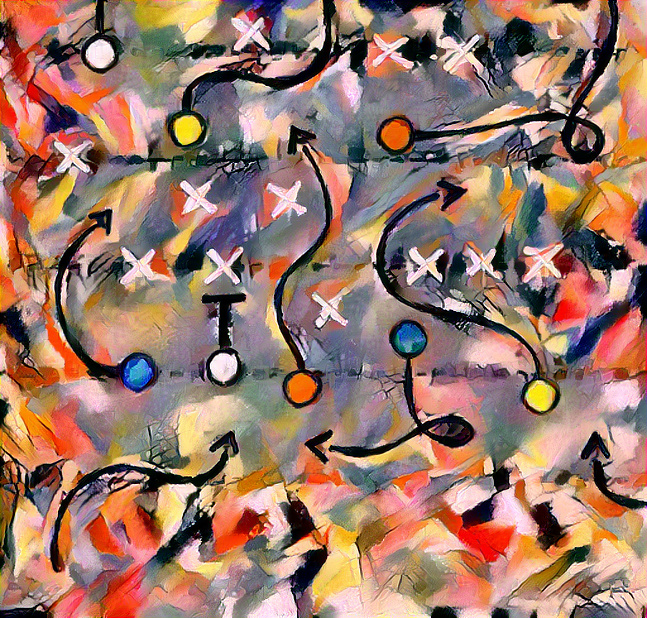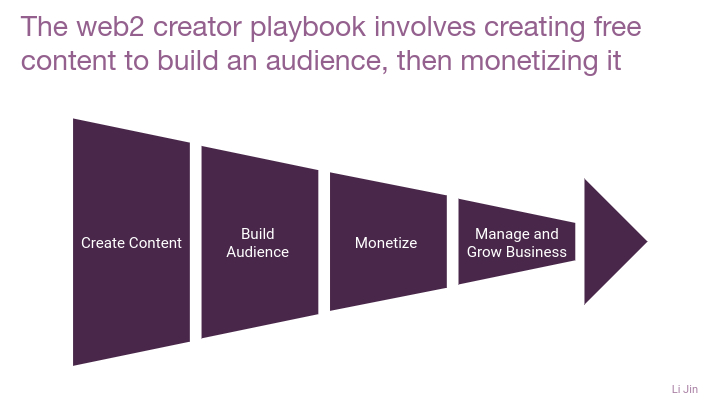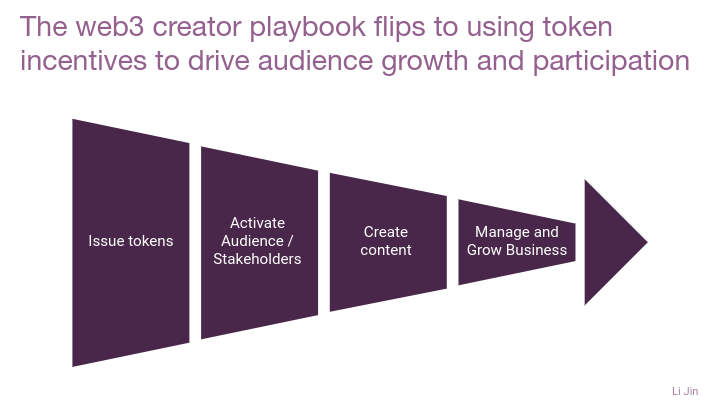
The New Creator Playbook: Jumpstarting Communities Through Tokens
Web3 is inverting the online creation model
September 16, 2022
When musician Daniel Allan set out to make his album Overstimulated in 2021, he could have done what a lot of internet creators do: spend months or even years creating and releasing his content, in the hopes of eventually building a big enough fanbase to fund his work full-time. Or, he could have gone an even more traditional route: shopped his work around to traditional music labels, hoping one of them would bestow on him that rarest of prizes—a record deal.
Instead, Daniel chose a different path: he crowdfunded his new album through a token sale on Mirror and raised 50 ETH (about $142K USD at the time) from 87 backers to fund the creation of his music. In return for their investment, token holders got a 50% stake in the artist share of the profits—and a direct line to Daniel himself. “For the first time, I owned all of the music that I was putting out and people were assigning an actual value to my art,” he wrote on his Mirror page about the impact crypto has had on his work.
Web3-native creators like Daniel represent the vanguard of a new model for the creator economy. We’ve written extensively about how networks and platforms can distribute user ownership through tokens in order to grow bigger and faster. Similarly, tokens also represent a powerful new tool for creators to bootstrap audiences and capital. Instead of creating content for free with the hopes of gradually growing an audience and one day being able to monetize it, creators are now able to monetize and build an audience upfront through tokens—and then use that money and that following to produce their content and grow their business.
In other words: web3 has inverted the traditional online content creation model. It’s a paradigm shift that will have significant implications for how creator work gets done, how followers relate to the work of creators, and how the broader creator ecosystem functions as a whole.
The evolution of the creator playbook
This isn’t the first time the creator playbook has seen an update. Pre-internet, creators conceived of their content, then pitched that content to institutions such as record labels, book publishers, TV studios, etc. who had the power to decide what got made. Creators then gave up significant creative control and a substantive chunk of future earnings in exchange for upfront funding and distribution of their work.
With the rise of web2 user-generated content platforms, a new pathway to creative work emerged. Creators were able to publish their work online to platforms like Instagram and TikTok and reach audiences directly. As their audience grew, various monetization paths became available including advertising, brand sponsorships, subscriptions, and merchandise.
The traditional creator lifecycle
Under the web2 model, creators are able to retain creative ownership of their work, yet face a long road to financial viability. Creators invest significant amounts of time and effort upfront into creating content—without knowing when or if they will see a return on that effort. That dynamic has contributed to creator burnout and poses a barrier to entry for less well-off creators.
In other words, creators working under the web2 model face a cold-start challenge: in order to make money, they need to have an audience, but in order to grow their audience, they need to have the resources to fund content creation. The web3 creator playbook is a new way to overcome that cold-start problem.
The web3 creator playbook: tokens bootstrap audience & capital
The web3 model takes the web2 creator playbook and inverts it. Instead of starting with creating free content in an effort to build a large fanbase that can later be monetized, web3 creators start by monetizing through the creation of a token (NFT or fungible). This attracts an initial audience of fan-owners interested in the potential upside that stems from ownership of an asset. The creator can then use the initial funding and stakeholders from the token sale to bootstrap their creative work. The fan-owners then have skin in the game to see that creator succeed and are incentivized to act as evangelists for the creator and their work. That helps to kickstart the virtuous cycle of content creation, audience growth, and monetization.
The key to this playbook is digital scarcity: as the creator becomes more well-known or successful, the token becomes more sought-after and valuable. The significance of digital scarcity through tokenization is unpacked in my blog post about the implications of web3 on the creator economy:
In tokenizing their work as an NFT, creators create a verifiable on-chain record of a piece of media’s ownership and provenance. The end result is a unique digital asset that traces back to the artist. Fans who are passionate about the creator’s work are willing to pay more for this canonical piece of media, enabling creators to better capture fans’ full willingness to pay.
The web3 creator lifecycle
This web3 creator model mirrors what Chris Dixon has outlined for bootstrapping networks with token incentives. In a traditional network, the utility to users of a new network is limited to the utility of the application—or, in the case of creators, their creative product. Tokens introduce an additional source of utility: financial utility. In the early days of a network—or of a creator’s journey—the token provides an supplemental source of utility for the audience.
Source: a16z
There are numerous examples of this already happening across various creative verticals. In the film world, Shibuya raised 400 ETH ($1.2M) for the production of an animated series called White Rabbit through a sale of NFT Producer Passes, which allow holders to decide the outcome of each chapter and become owners of the finished film. Similarly, animator/filmmaker Robbie Shilstone raised over 324 SOL through NFTs on the platform Formfunction, enabling dozens of backers to be involved in the film’s production process. In reality TV, Mad Realities crowdfunded 172 ETH through an NFT sale for its dating show, wherein NFT owners have various governance powers including ability to vote on the cast each week, sending gifts to contestants while filming, and voting on the winning couple. In the publishing world, Tally Labs’ upcoming novel Bored & Dangerous incorporated 2,800 Writers Room NFT holders into the writing process, with NFT holders able to license characters to the book and vote on the direction of the story. In music, many web3 artists have done similar experiments to Daniel Allan, airdropping tokens to backers and providing benefits like listening parties and access to token-gated content.
In these examples, not only are tokens helping creators to fund their work upfront, but in many instances, tokens served as shelling points for an audience to even form in the first place. With the incentive alignment afforded by a token, those audiences became active co-creators and stakeholders with an incentive to guide and shape the work and evangelize it.
What this means for the creator economy
While the use of tokens by creators is still nascent, there are three areas, in particular, where the new creator playbook is likely to impact the creator economy: the accessibility of creative work, the nature of fandom, and the role of creators themselves.
1. Creative paths become more accessible
Under the web2 creator model, creators typically spend a long time creating free content before seeing any return on investment. Because this token playbook accelerates access to capital and audience, it lowers this financial barrier, allowing a wider range of aspiring creators to pursue a creative career.
There are still obstacles to be reckoned with, of course. While this playbook jumpstarts capital and audience growth, it doesn’t remove the upfront effort needed to cultivate a small, passionate following so that the creator’s tokens are well-received. While Daniel Allan only had about 200 Twitter followers at the time of his crowdfund—an audience size that would have been nonviable for traditional monetization models like advertising—he did have to spend considerable time cultivating relationships with collectors. A Billboard article describes: “In the months leading up to the Overstimulated release, Allan spent eight hours a day on Twitter and Discord. He sent out messages to everyone in the Web3 music space. He dropped into dozens of Discord servers to say “gm” (good morning) and make connections with music NFT collectors. [...] By the end of the campaign, the Overstimulated EP had 87 backers—at least 50 of whom Allan had made personal connections with beforehand.” The web3 creator playbook reduces the total size of the audience needed to monetize, but actually makes it more important to build deeper relationships with fewer, truer fans.
Another major hurdle is education and access: in order for creators to take advantage of the new creator playbook, they have to be aware that the pathway even exists and have access to the tools that make it possible. This is why it is crucial for the web3 ecosystem to continue to invest in developing resources and tools that are accessible to users of all backgrounds. Educational programs like Seed Club’s accelerator, Forefront’s Web3 Creator Residency, HIFI Labs’ Web3 Artist Cohort Program, and the Music NFT Launchpad are examples of initiatives serving an important need in onboarding more creators to web3.
2. The nature of fandom evolves
In the web2 creator economy, the relationship between creators and audiences is largely unidirectional. The web3 creator playbook incentivizes and opens a path for a significantly more active role for fans, along two main vectors:
From fans to investors
Under the web2 creator model, fans are attracted to creators for intrinsic reasons—because they love the creator’s work. The web3 model introduces an additional motivation: ownership. Some supporters will be attracted for speculative reasons—because they see ownership as a requisite to profiting from resale.
This has the potential to change the dynamic between creators and their community as token ownership shifts incentives. How does it change the relationship between creators and audiences when fans experience a financial loss? Will fans withdraw their support if their tokens decrease in value? These are questions that the creator ecosystem will have to navigate as the new creator playbook matures.
From passive spectators to active stakeholders
Traditionally, content creation has been a one-directional process: creators create the work, and audiences consume it. The new creator playbook turns creative work into a participatory process, where token holders want to have a direct impact on the work itself because they are financially exposed to its success. An example of this is Jenkins the Valet, a single Bored Ape NFT whose entire existence and persona was crafted by its owner, and which is now signed to CAA and serves as the basis of entirely new creative projects. All of these derivative projects serve to accrue value back to the Bored Ape ecosystem by raising the prominence of the collection. It’s hard to imagine a fan in traditional contexts going to such lengths to help a creator succeed, but web3 offers alignment of financial interests such that community participants are incentivized go the extra mile.
There are unknown impacts associated with this shift. Does audience participation in the co-creation process enhance or restrict creative potential? How will creators balance their own creative vision with the visions of their backers?
3. The creator persona changes
Fans aren’t the only ones that stand to evolve with the adoption of the web3 playbook—creators themselves will see their roles change. That’s because the web3 creator playbook changes the composition of skills needed for creators to be successful.
Rather than focusing on simply creating content themselves, creators have to become skilled at marketing, cultivating relationships, and community management from the outset (or deputize community members who possess these skills). They must function a lot like startup founders: raising capital, evangelizing their vision, and balancing stakeholder interests along the way. This is taken to the extreme under the increasingly popular CC0 model (“no copyright reserved”), wherein creators allow others to use their work in any way, including for commercial purposes. The role of a CC0 creator becomes more about community management and stewardship, rather than first-party content creation.
Again, the broader ramifications of this shift remain to be seen. Could input and expectations from fan-investors create disjointed output, stymie creative potential, and induce more creator anxiety and burnout? Or will it help creative projects, as a larger community rallies around their work?
More options for creators means a more vibrant creator economy
The story of the creator economy over the past few decades and centuries has been one of an unleashing of potential, through greater access, business models, and lower barriers to entry through new technologies. Token incentives represent an exciting new tool for the creator economy, allowing creators to bootstrap supporters, harness new monetization and value capture mechanisms, and co-create with their audiences.
Just as the web2 playbook didn’t supplant traditional publishing, the web3 playbook doesn’t completely replace the web2 creator economy playbook. Rather, it opens up new potential roads for creators to take, which will result in a stronger and more vibrant creator economy.
If you’re a founder building in this space or creator experimenting with new models, I’d love to chat: li@variant.fund.
With thanks to Katie Parrott.
Additional reading:
- The Ownership Economy 2022 by the Variant team
- The Web3 Playbook: Using Token Incentives to Bootstrap New Networks by Chris Dixon
- The Web3 Renaissance by Li Jin and Katie Parrott
- Tweetstorm about the new creator playbook by Li Jin
Find Out What
Comes Next in Tech.
Start your free trial.
New ideas to help you build the future—in your inbox, every day. Trusted by over 75,000 readers.
SubscribeAlready have an account? Sign in
What's included?
-
Unlimited access to our daily essays by Dan Shipper, Evan Armstrong, and a roster of the best tech writers on the internet
-
Full access to an archive of hundreds of in-depth articles
-
-
Priority access and subscriber-only discounts to courses, events, and more
-
Ad-free experience
-
Access to our Discord community





Comments
Don't have an account? Sign up!